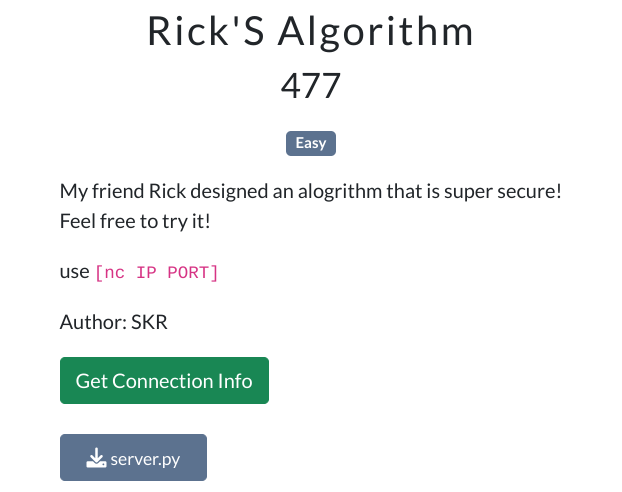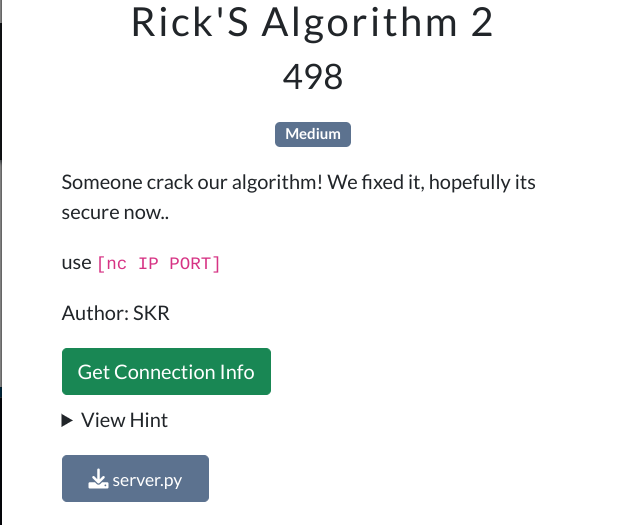Rick'S Algorithm | Wargames.MY CTF 2024
Published on
Rick'S Algorithm (crypto)

Let's see what we have in server.py
from Crypto.Util.number import *
import os
from secret import revealFlag
flag = bytes_to_long(b"wgmy{REDACTED}")
p = getStrongPrime(1024)
q = getStrongPrime(1024)
e = 0x557
n = p*q
phi = (p-1)*(q-1)
d = inverse(e,phi)
while True:
print("Choose an option below")
print("=======================")
print("1. Encrypt a message")
print("2. Decrypt a message")
print("3. Print encrypted flag")
print("4. Print flag")
print("5. Exit")
try:
option = input("Enter option: ")
if option == "1":
m = bytes_to_long(input("Enter message to encrypt: ").encode())
print(f"Encrypted message: {pow(m,e,n)}")
elif option == "2":
c = int(input("Enter ciphertext to decrypt: "))
if c % pow(flag,e,n) == 0 or flag % pow(c,d,n) == 0:
print("HACKER ALERT!!")
break
print(f"Decrypted message: {pow(c,d,n)}")
elif option == "3":
print(f"Encrypted flag: {pow(flag,e,n)}")
elif option == "4":
print("Revealing flag: ")
revealFlag()
elif option == "5":
print("Bye!!")
break
except Exception as e:
print("HACKER ALERT!!")
So, like any other this is an oracle where one can encrypt/decrypt a message using RSA encryption.
The first attack that came to my mind was Hastad's Broadcast Attack. However that would required 1367 pairs of public modulus and the ciphertext. But often such oracles are susceptible by Choosen Ciphertext Attacks. This means that we can choose a ciphertext to decrypt such that the resulting decrypted message contains flag as a factor. To perform this we typically take an integer $r$. Consider the ciphertext to be as $ct$. Now consider
$$
\begin{align*}
ct^{\prime} = ct \cdot r^{e} \\
\end{align*}
$$
Where $ct$ is the flag ciphertext and $e$ is the public exponent. When this number is sent to the oracle to decipher, ($pt^{\prime}$ being the altered plaintext, $d$ is the private key and $N$ is the public modulus)
$$
\begin{align*}
pt^{\prime} &= (ct^{\prime})^{d} \mod N \\
pt^{\prime} &= (ct \cdot r^{e})^{d} \mod N \\
pt^{\prime} &= (ct^{d} \cdot r^{ed}) \mod N \\
pt^{\prime} &= (ct^{d} \mod N \cdot r^{ed} \mod N) \mod N \\
\end{align*}
$$
from $e \cdot d \equiv 1 \mod{\phi(N)}$, it follows that,
$$
\begin{align*}
pt^{\prime} &= (pt \cdot r^{1+k\phi(N)} \mod N) \mod N \\
pt^{\prime} &= (pt \cdot r \cdot r^{k\phi(N)} \mod N) \mod N \\
\end{align*}
$$
from Euler's Theorem we've, $a^{\psi(b)} \equiv 1 \mod b$ if $gcd(a,b) = 1$.
In this case $gcd(a,b)=gcd(r^{k},N)=gcd(r^{k},pq)$. Since $p$ and $q$ are prime, this implies $gcd(r^{k},pq)=1$ is always true (given $r^{k} < min(p,q)$) and hence one can say $r^{k\phi(N)} \mod N = 1$
$$
\begin{align*}
pt^{\prime} &= (pt \cdot r) \mod N \\
\end{align*}
$$
And the altered plaintext will be $r$ times the actual flag.
However this one has this interesting line:
if c % pow(flag,e,n) == 0 or flag % pow(c,d,n) == 0:
This disables one to use above approach to get the flag. And that's what we have to do in this challenge: bypass this check.
The second check says that if $flag=k \cdot pt^{\prime}$ then the script raises an hacking alert. This is reduntant if $pt^{\prime} > flag$.
For the first check, consider
$$
\begin{align*}
ct^{\prime} &= (ct \cdot r^{e}) \mod N \\
pt^{\prime} &= ((ct \cdot r^{e}) \mod N)^{d} \mod N \\
pt^{\prime} &= ((ct^{d} \cdot r^{ed}) \mod N) \mod N \\
pt^{\prime} &= ((ct^{d} \mod N \cdot r^{ed} \mod N) \mod N) \mod N \\
pt^{\prime} &= (ct^{d} \mod N \cdot r^{ed} \mod N) \mod N \\
\end{align*}
$$
since the last modulo is reduntant. Afterwards the calculation is same as the above.
Another thing in this challenge was that the piblic modulus $N$ was not provided. Hence we had to retrieve that by sending some messages as first.
from Crypto.Util.number import long_to_bytes, bytes_to_long
from pwn import *
import gmpy2
def recover_n(pairings, e):
pt1, ct1 = pairings[0]
N = ct1 - pow(pt1, e)
for pt,ct in pairings:
val = gmpy2.mpz(ct - pow(pt, e))
N = gmpy2.gcd(val, N)
return N
HOST = "43.217.80.203"
PORT = 34235
conn = remote(HOST, PORT)
e = 0x557
msgs = ["Hey Jude, don't make it bad.",
'Take a sad song and make it better.',
'Remember to let her into your heart,',
'Then you can start to make it better.',
"Hey Jude, don't be afraid."]
pairings = []
for msg in msgs:
conn.sendline(b"1")
conn.sendline(msg.encode())
conn.recvuntil(b"Encrypted message:")
ct = int(conn.recvuntil(b"\n").decode().strip())
pt = bytes_to_long(msg.encode())
pairings.append((pt, ct))
conn.sendline(b"3")
conn.recvuntil(b"Encrypted flag:")
flag = int(conn.recvuntil(b"\n").decode().strip())
N = recover_n(pairings,e)
fflag = (flag*pow(2,e)) % N
conn.sendline(b"2")
conn.recvuntil(b"Enter ciphertext to decrypt: ")
conn.sendline(str(fflag).encode())
conn.recvuntil(b"Decrypted message:")
print(long_to_bytes(int(conn.recvuntil(b"\n").decode().strip())//2))Flag: wgmy{ce7a475ff0e122e6ac34c3765449f71d}
Rick'S Algorithm 2 (crypto)

Again, let's check server.py
from Crypto.Util.number import *
import os
from secret import revealFlag
flag = bytes_to_long(b"wgmy{REDACTED}")
p = getStrongPrime(1024)
q = getStrongPrime(1024)
e = 0x557
n = p*q
phi = (p-1)*(q-1)
d = inverse(e,phi)
while True:
print("Choose an option below")
print("=======================")
print("1. Encrypt a message")
print("2. Decrypt a message (Disabled)")
print("3. Print encrypted flag")
print("4. Print flag")
print("5. Exit")
try:
option = input("Enter option: ")
if option == "1":
m = bytes_to_long(input("Enter message to encrypt: ").encode())
print(f"Encrypted message: {pow(m,e,n)}")
elif option == "2":
print(f"Disabled decryption to prevent flag leaking!")
elif option == "3":
print(f"Encrypted flag: {pow(flag,e,n)}")
elif option == "4":
print("Revealing flag: ")
revealFlag()
elif option == "5":
print("Bye!!")
break
except Exception as e:
print("HACKER ALERT!!")
Unlike the previous one this has disabled the decrypt flag option and hence we cannot use that again. Again, Hastad's Attack came to my mind. In brief, if a message $M$ is encrypted $e$ times using same public exponent and different modulus $N_{i}, 1 \leq i \leq e$ then,
$$
\begin{align*}
M^{e} &\equiv ct_{1} \mod N_{1} \\
M^{e} &\equiv ct_{2} \mod N_{2} \\
M^{e} &\equiv ct_{3} \mod N_{3} \\
\vdots & \\
M^{e} &\equiv ct_{e} \mod N_{e} \\
\end{align*}
$$
This system of congruences can be solved by Chinese Remainder Theorem and flag can be retrieved by taking the $e$-th root of the solution.
Unfortunately, I am still not able to solve this problem because gathering 1367 pairs of modulus and ciphertext is a tedious task (atleast for me). My script would just take forever to run. I will update this writeup again if I could find an alternate solution or my script executes fully.
Anyway, here's my script:
from Crypto.Util.number import long_to_bytes, bytes_to_long
from pwn import *
import gmpy2
from sympy.ntheory.modular import crt
gmpy2.get_context().precision=700
def recover_n(pairings, e):
pt1, ct1 = pairings[0]
N = ct1 - pow(pt1, e)
for pt,ct in pairings:
val = gmpy2.mpz(ct - pow(pt, e))
N = gmpy2.gcd(val, N)
return N
HOST = "43.216.228.210"
PORT = 32859
e = 0x557
msgs = ["Hey Jude, don't make it bad.",
'Take a sad song and make it better.',
'Remember to let her into your heart,',
'Then you can start to make it better.',
"Hey Jude, don't be afraid."]
Ns = []
flags = []
for i in range(e):
pairings = []
conn = remote(HOST, PORT)
for msg in msgs:
conn.sendline(b"1")
conn.sendline(msg.encode())
conn.recvuntil(b"Encrypted message:")
ct = int(conn.recvuntil(b"\n").decode().strip())
pt = bytes_to_long(msg.encode())
pairings.append((pt, ct))
conn.sendline(b"3")
conn.recvuntil(b"Encrypted flag:")
flag = int(conn.recvuntil(b"\n").decode().strip())
N = recover_n(pairings,e)
Ns.append(N)
flags.append(flag)
conn.close()
c = crt(flags,Ns)[0]
# print(c)
print(long_to_bytes(int(gmpy2.root(c,e))))Flag: Pending